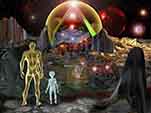Wednesday February 28 4:33 PM ET
Big Quake Rattles Seattle, Injuries Reported
By Chris Stetkiewicz and Scott Hillis
SEATTLE (Reuters) - A strong earthquake measuring 6.8 in magnitude and lasting about 45 seconds rocked Seattle on Wednesday, knocking chunks of masonry from skyscrapers and forcing thousands to flee their homes, schools and offices.
There were reports of about a dozen people hurt, including three with serious injuries from being crushed by debris.
The quake at 10:54 a.m. local time (1:55 p.m. EST), which was also felt in Vancouver, British Columbia, to the north and Portland, Ore., to the south, damaged many buildings in the
earthquake-prone city of about 500,000 -- including the corporate headquarters of coffee house chain Starbucks.
The U.S. Geological Survey in Golden, Colorado first reported the earthquake measured 7.0, but then reduced that figure to 6.8 -- a size that still carries potential for major damage. This did not
result because of the quake's substantial depth, estimated at about 30 miles.
Geophysicists at the USGI's earthquake information center in Golden said measurements put the quake at a magnitude 7.0, with an epicenter some 30 miles southwest of Seattle, and 10 miles
northeast of the state capital Olympia along the coast of Puget Sound.
Gates Speech Halted
A speech by Bill Gates, the head of software giant Microsoft, was interrupted, 30 people were stranded at the top of the city's Space Needle tower before being rescued and the offices of coffee shop chain operator Starbucks were damaged. CNN reported that the dome of the state capitol building in Olympia, Wash., was cracked.
Seattle Mayor Paul Schell told reporters: ``I think we have weathered it. It looks so far as if everything is working but it is too soon to tell. It's the biggest quake I remember.''
Schell, speaking from the city's emergency operations center, said there no reports of fires or major injuries.
It was the largest quake for Seattle in 36 years, when a 6.5 tremor rocked the region on April 29, 1965. Seattle sits on a fault caused by the Juan de Fuca plate sliding under the continental United States. A 7.1-magnitude temblor in 1949 killed eight people.
Harborview Medical Center was treating 12 people for injuries but there were no reports of fatalities.
One driver apparently panicked during the quake and swerved off the road, hitting a pedestrian, who was being treated for injuries, local television said.
``We started bouncing off the walls and we could feel ourselves falling a little bit after we threw the stop switch.'' said Todd Baren, a worker with Internet name registry eNic Corp., who was in an elevator in a downtown office building.
``After we finally stopped we were just swaying, we could feel the elevator banging against the walls, and after 15 minutes the technicians pulled us out and they said we'd fallen a couple floors,'' Baren said.
One local television station which had been taping a downtown news conference caught the moment the quake struck on tape. It showed pictures swaying on an office wall, and people clutching at desks to steady themselves.
Maria Ackley, 62, a resident of Mercer Island, a quiet residential community east of Seattle, was in the kitchen of her home with her husband when the quake struck.
``When it first happened, there was a thundering sound. The doors in the house were rattling and the windows in the kitchen were rippling, literally. It looked like they were waves of water.
Everything was shaking. You felt like you were at sea,'' she said.
Walls Fracture
``All the drawers opened up, and any container that had something in it emptied out. And we ran out of the house and our car was in motion,'' she said. When the temblor was over, her husband found a ``major fracture'' in the home's foundation.
Her son, Andrew, 17, said his high school was immediately evacuated and everyone was sent home. There were no apparent injuries, he said.
Seattle's Sea-Tac airport was closed ``until further notice'' and its control tower had been evacuated, officials said. Flights to Seattle were being canceled or diverted to other airports.
Helicopter pictures showed traffic flowing normally on most major roads shortly after the quake and no signs of fires or major damage.
Television pictures showed some collapsed exterior walls, shattered windows and damaged cars but Seattle's major downtown tower blocks appeared to be intact.
The quake rocked skyscrapers, knocking books off shelves, sending doors flying open and driving frightened residents and workers out into the streets.
``We're on the third floor and pictures were falling off the walls, and water was splashing on the floor,'' said one worker at a public relations firm. ``I was on the phone with a friend and she started screaming.''
The wail of police and fire sirens filled Seattle's gray winter skies, but no major casualties or damage were immediately reported. Local television showed crowds of people gathered in the downtown area's historic Pioneer Square after the quake.
``There are pockets of damage but nothing catastrophic that we can see,'' a local television reporter said from a helicopter surveying parts of the city.
Officials in King County where Seattle is located said a county-wide state of emergency had been declared, allowing inspectors to enter buildings to check for structural damage.
The Harborview Medical Center, one of Seattle's biggest hospitals, quickly evacuated staff and visitors as the quake hit, with one witness telling local television that a concrete wall in the building had splintered apart.
``The whole concrete wall started to split and shattered into pieces and started to come down,'' the unidentified woman told the television. The facility was still open.
Hospital Handles Problems
``Harborview is prepared and equipped to handle serious and critical patients coming in so they will be able to care for those patients,'' a hospital spokeswoman said.
The earthquake sent a strong jolt as far south as Portland, Oregon.
``I thought I was having a vertigo attack. It was shaking us pretty good ... we're not used to anything like that up here,'' said Mike Hansen, a spokesman at the Portland-based Bonneville
Power Administration.
David Horsey, 49, a Pulitzer Prize-winning political cartoonist for the Seattle Post-Intelligencer, said he was looking out his office window watching a freight train roll by as he felt a strong rumbling.
``I had a momentary thought that, 'Man, that guy is shaking the ground here.' That turned quickly to the realization that it was something a lot bigger than that.
``I went over and stood in the doorway. It felt like being in a boxcar bouncing around. The building was rattling, the doors were slowly opening by themselves,'' he said.
As the shaking continued, Horsey recalled being told that the building was on landfill that could liquefy in the event of a major earthquake and his initial feeling of excitement turned to thoughts of ``'What if the roof caves in? What if this is the Big One? How screwed am I?'''
Michael Hosterman, 58, a financial planner who works downtown, said he was on the telephone ``talking to someone, and he suddenly said, 'Earthquake! Bye!' And our building just started rolling like somebody was pushing on it, swaying back and forth.''
``A wall unit was starting to fall over, and my secretary was screaming, 'Stand in the doorway! Stand in the doorway!' and it went on for a long time.''
Asked if anyone were hurt, Hosterman said, ``Physically everybody is okay, but everybody is not okay mentally.''
-----






































